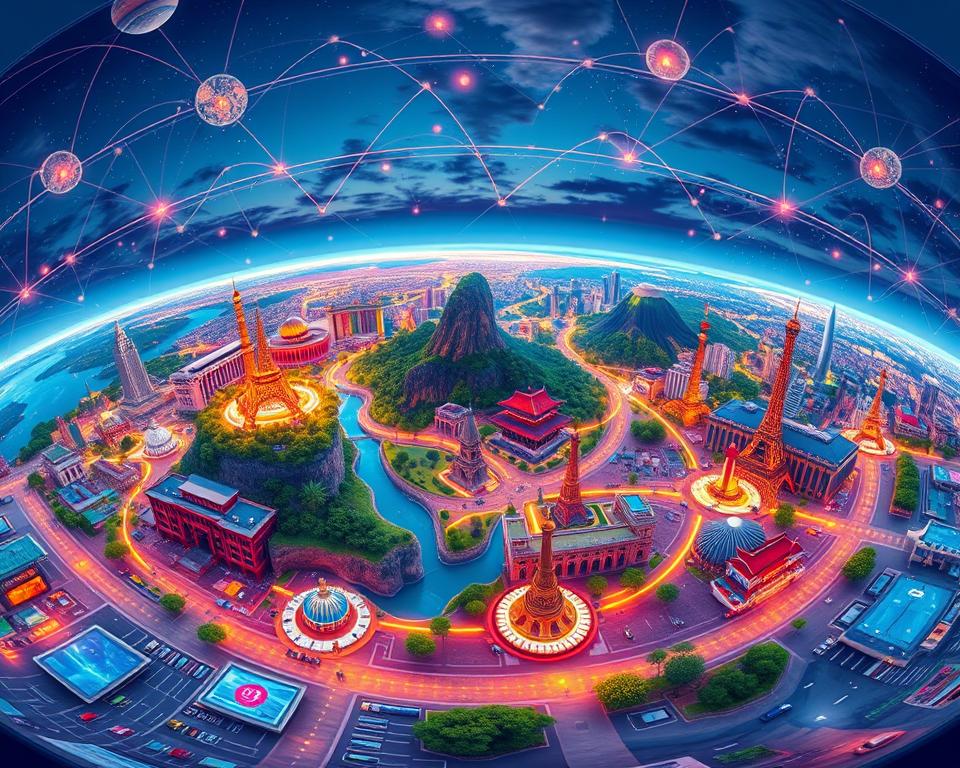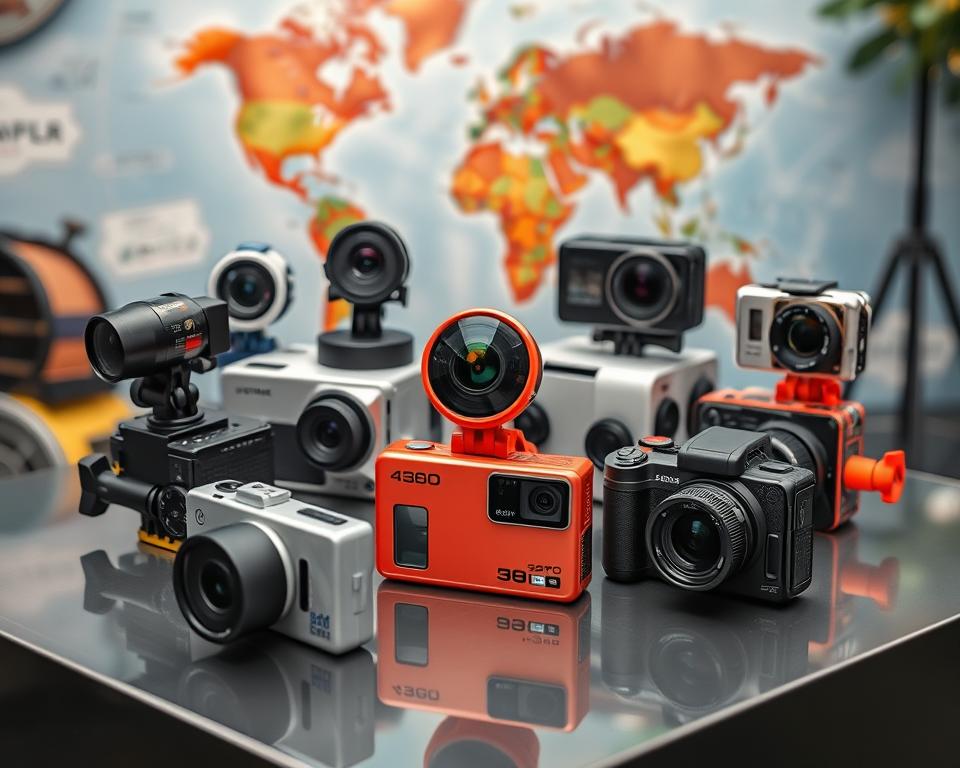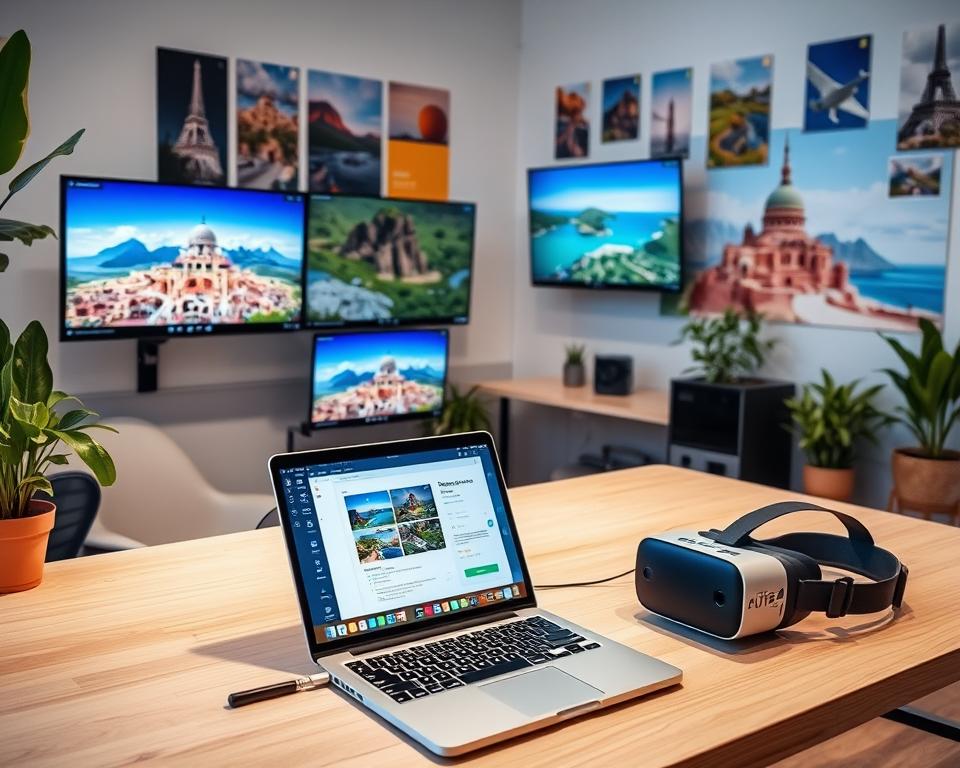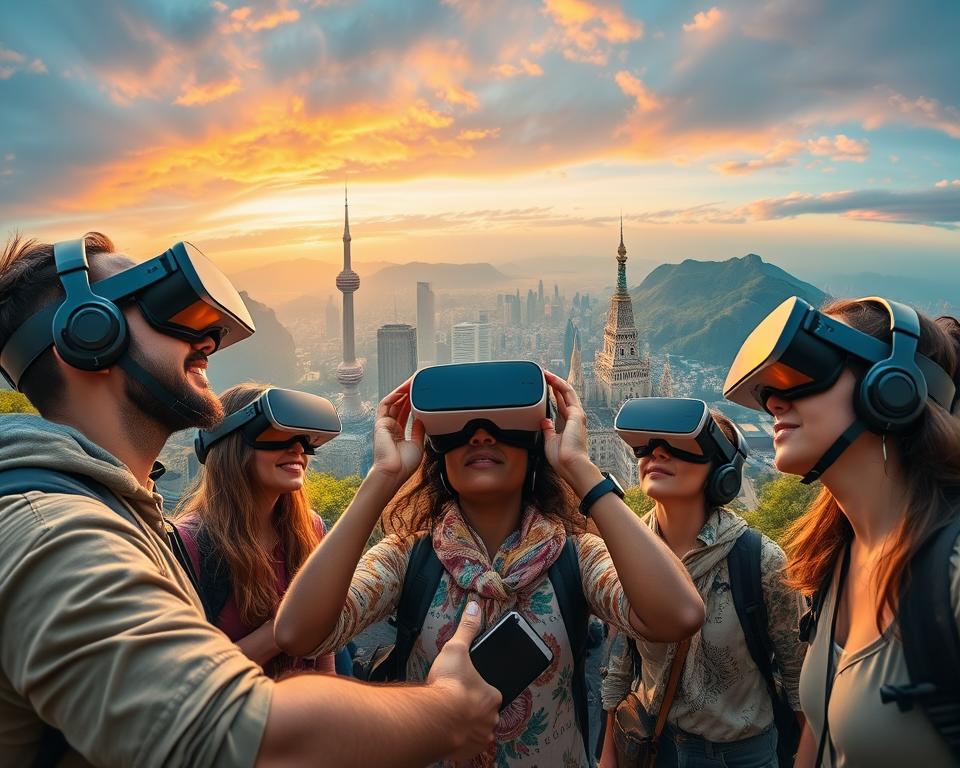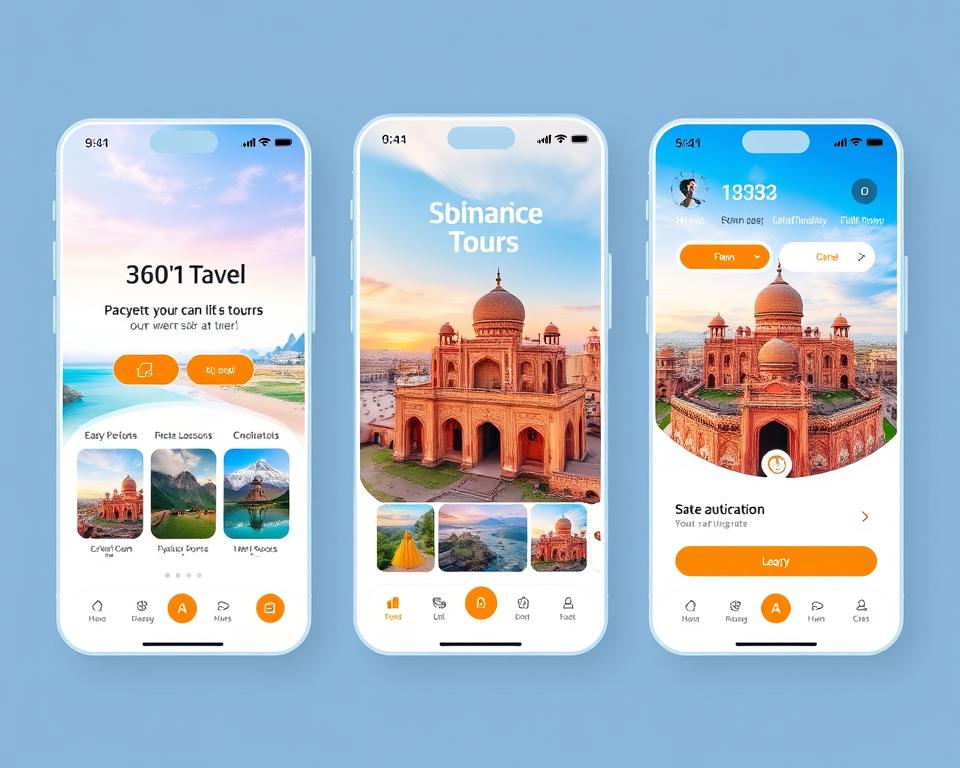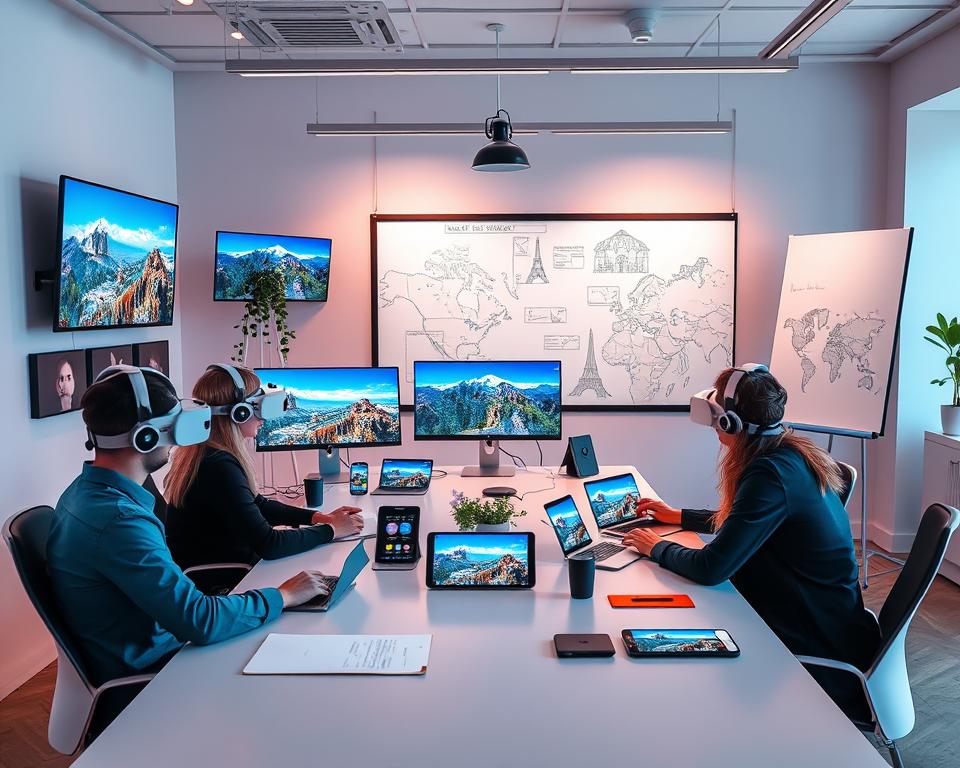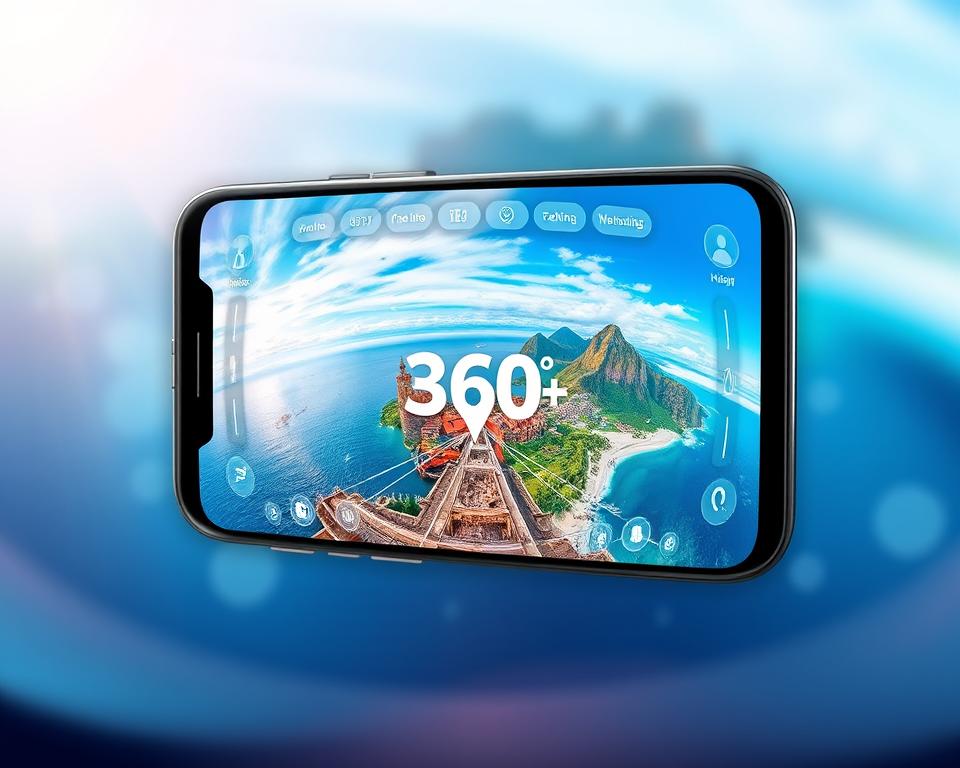The travel world has changed a lot in the digital age. Now, more people want to explore places virtually. Virtual travel apps offer 360-degree tours that let you see the world from home.
This guide will show you how to make a virtual travel app. It will cover everything from understanding the market to making money. It’s for developers and entrepreneurs who want to change how we travel today.
Table of Contents
Key Takeaways
- Understand the virtual travel app market landscape, including current trends, key players, and target audience demographics.
- Identify essential features for a successful virtual travel application, such as 360-degree tours and interactive user experiences.
- Explore the technical requirements for integrating 360-degree tours, including camera specifications, software development tools, and platform compatibility.
- Develop a content strategy that focuses on destination selection, content creation guidelines, and quality control standards.
- Implement user interface design principles to ensure a seamless and intuitive user experience.
Understanding the Virtual Travel App Market Landscape
The virtual tourism market is booming as digital travel trends change. People love exploring places from home. This has made the virtual travel app world very competitive.
Current Market Trends and Opportunities
Several trends are shaping the virtual travel app market. These include a desire for personal and interactive experiences. Also, there’s a push for eco-friendly and sustainable tourism. These trends offer big chances for app developers to innovate.
Key Players and Competitors Analysis
Big names like Google Earth VR and Ascape lead the market. They offer 360-degree tours and interactive features. But, new apps can stand out by offering unique content and customizable experiences.
Target Audience Demographics
The people using virtual travel apps vary a lot. They range from tech-savvy millennials to older travelers. Knowing who they are and what they want is key to making a successful app.
“The virtual tourism industry is poised for exponential growth as consumers seek more immersive and engaging travel experiences.”
By studying the virtual travel app market, developers can find new trends and understand their audience. This helps them create an app that offers something special and meets user needs.
Essential Features for a Virtual Travel Application
To create a virtual travel experience, you need to pick the right features. These features should grab users’ attention and take them to their dream places. A good virtual travel app has key elements that make the experience better and connect users with their destinations.
360-degree panoramic views are a must-have. They let users explore places like they were there. With these views, users can walk through cities, see beautiful landscapes, or visit famous spots. It feels like they’re really there.
An interactive map is also important. It makes it easy for users to find places they want to see. They can plan their trip and get more info about places they’re interested in. This makes planning and discovering new places fun.
- Captivating 360-degree panoramic views
- Interactive maps for intuitive navigation
- Immersive audio guides for a deeper cultural experience
- Social sharing capabilities to inspire and connect with others
Audio guides add a lot to the experience. They share the history, culture, and local tips of a place. This makes the journey more real and educational.
Lastly, social sharing features let users share their adventures. This connects them with others who love to travel. It also helps the app grow by getting more people to use it.
By combining these features, virtual travel apps offer a unique experience. They go beyond just planning trips. With the right design and features, these apps change how we explore the world from home.
Technical Requirements for 360-Degree Tour Integration
Virtual travel apps are getting better, and 360-degree tours are key to a great experience. Developers need to know about cameras, software, and where to use it all.
Camera and Equipment Specifications
For top-notch 360-degree videos, the right camera matters. The GoPro Fusion and Insta360 One X2 are great choices. They make videos that look amazing and feel real.
Using tripods and stabilizers helps too. They keep the video smooth and steady. This makes the experience better for everyone.
Software Development Tools
- VR development tools like Unity and Unreal Engine are essential. They help create 3D worlds and animations. This makes virtual tours feel real.
- For editing, Adobe Premiere Pro and Insta360 Studio are great. They let developers make the 360-degree videos better before they’re used in the app.
Platform Compatibility Requirements
It’s important for virtual travel apps to work on many devices. This includes phones, tablets, and VR headsets. Developers must make sure the 360-degree tours work well on all these platforms.
“Integrating 360-degree tours is a game-changer for virtual travel applications, as it allows users to fully immerse themselves in the destinations they explore, ultimately enhancing the overall experience and driving greater engagement.”
Setting Up Your Development Environment
Creating a virtual travel app needs a well-organized setup. Developers should learn about the latest app development setup and virtual reality tools.
Choosing the right Integrated Development Environment (IDE) is key. It should support your chosen platform and programming languages. Android Studio is great for Android, Xcode for iOS, and Unity or Unreal Engine for all platforms.
Also, setting up the necessary Software Development Kits (SDKs) and Application Programming Interfaces (APIs) is crucial. This lets you integrate 360-degree tours and other software tools smoothly.
| Tool | Purpose |
|---|---|
| Git | Version control system |
| Trello | Project management platform |
| Slack | Team communication tool |
For better development, use a version control system like Git. Also, pick project management tools like Trello or Jira. They help track progress, manage tasks, and improve team work.
“Setting up a robust development environment is the foundation for creating a successful virtual travel app. The right tools and processes can significantly boost productivity and ensure the project stays on track.”
Planning Your Virtual Tour Content Strategy
Creating a great virtual tour content strategy is key to grabbing your audience’s attention. It’s about showing off the special charm of your destinations. This involves careful planning and making sure the content is top-notch.
Destination Selection Criteria
When picking destinations for your virtual tours, think about these:
- Iconic landmarks and architectural wonders that are visually stunning
- Cultural hubs that highlight local traditions and heritage
- Natural wonders, like beautiful landscapes and wildlife
- Special food experiences that excite the senses
Content Creation Guidelines
Quality is crucial for a great virtual tour experience. Here’s how to keep it high:
- Use 360-degree cameras for a full view
- Work with skilled camera teams for the best visuals
- Add interactive features like hotspots to improve the user experience
- Make sure the content works well on all devices and platforms
Quality Control Standards
Having a strong quality control process is vital. It ensures your virtual tour content is top-notch. This includes:
| Quality Aspect | Evaluation Criteria |
|---|---|
| Visual Fidelity | Clarity, resolution, and color accuracy |
| Interactivity | Smooth navigation, responsive hotspots, and seamless transitions |
| Content Accuracy | Factual information, cultural authenticity, and attention to detail |
By following these best practices, you can make a virtual tour that captivates your audience. It will make your app stand out from the rest.
Implementing User Interface Design Principles
In the world of virtual travel apps, UI and UX design are key. They make the app engaging and fun to use. A good app has a user-friendly interface that is easy to navigate and looks great.
One main rule in UI/UX design is to make navigation easy. Users should be able to find what they need quickly. This means clear menus, simple gestures, and controls that work well.
The app’s design should also look good and work well. The right colors, fonts, and images can make users feel like they’re really there. Adding features for different users, like changing font sizes, makes the app better for everyone.
| UI/UX Design Best Practices | Benefits |
|---|---|
| Intuitive Navigation | Seamless user experience, increased engagement |
| Visually Appealing Layouts | Immersive and engaging virtual environment |
| Accessibility Features | Inclusive and user-friendly app experience |
Following these UI/UX design rules helps developers make great virtual travel apps. These apps not only show off amazing virtual places but also make sure users have a great time exploring them.
“The key to a successful virtual travel app is to make the user experience as intuitive and engaging as the virtual destinations themselves.”
How to Create a Virtual Travel App with 360-Degree Destination Tours
Creating a virtual travel app with 360-degree tours is a detailed process. It needs careful planning, smooth execution, and thorough testing. Let’s dive into the main steps to make this app a reality.
Development Phases Overview
The app development journey has several key stages:
- Comprehensive planning and ideation: Define the app’s main features, who it’s for, and what makes it special.
- Design and user interface development: Make the app easy to use and fun to explore.
- Virtual tour content creation: Record top-notch 360-degree videos of places to visit.
- Software engineering and coding: Put the 360-degree tours and other features together.
- Thorough testing and optimization: Check the app works well, looks good, and is easy to use.
Core Functionality Implementation
The heart of a virtual travel app is its 360-degree tours. It’s important to plan how users will move around, control the app, and manage content. This ensures a fun and engaging experience. Focus on the app development process, virtual tour creation, and software testing to get a great app.
Testing and Optimization
Testing is key to find and fix problems, improve performance, and make the app better. It involves checking the app works well on different devices and with various users. Also, keep refining the app development process and virtual tour creation to make the app even better.
| Key Considerations | Objective |
|---|---|
| Usability and Accessibility | Make the app easy to use and accessible for everyone. |
| Content Quality and Optimization | Provide top-notch 360-degree tours that work smoothly and fast. |
| Compatibility and Cross-Platform Support | Ensure the app works well on all devices and systems. |
By carefully following each step, you can make a virtual travel app that amazes users. It will offer an unforgettable experience with its 360-degree tours.
Navigation and User Experience Optimization
Creating a great user experience is key for a successful virtual travel app. To make navigation better, developers should add interactive features and controls. This makes the app more fun and easy to use.
Gesture controls are a big part of making the app better. Users can move around the virtual tour by swiping, pinching, or tilting their device. This makes the experience feel more real and fun. It also helps new users get started faster.
Voice commands are another great feature. With speech recognition, users can tell the app what to do. They can explore, change views, or get more info without touching the screen. This makes using the app easier and more enjoyable.
Also, adding interactive elements like hotspots, tooltips, or mini-games can really help. These elements can make users want to explore more. They can find hidden details and have fun while doing it.
| Feature | Benefits |
|---|---|
| Gesture Controls | Improved immersion, reduced learning curve |
| Voice Commands | Enhanced convenience, hands-free navigation |
| Interactive Elements | Increased user engagement, exploration of key points of interest |
By using these new ways to navigate and improve the user experience, app developers can make a memorable trip for users. This leads to more fun and satisfaction for everyone.
Integrating Virtual Reality Components
Virtual reality (VR) technology is getting better, making travel apps more exciting. Now, travel apps can take users to their dream places. This offers a new level of engagement and realism.
VR Hardware Compatibility
For VR integration, it’s important to work with popular headsets. Devices like the Oculus Quest and HTC Vive are top choices. They offer high-quality, wire-free experiences that work well with mobile apps. Making sure your app works well with these platforms is key for a great virtual reality travel experience.
Interactive Features Development
The real strength of VR integration is in interactive features. Users can explore, interact with objects, and go on guided tours. This makes destinations come alive, creating a deep connection with the places users visit.
As VR tech improves, adding VR to travel apps will become more important. With seamless hardware and engaging features, travel apps can offer a virtual reality travel experience like never before.
Monetization Strategies for Virtual Travel Apps
The virtual travel app market is growing fast. App developers need to find ways to make money to keep their apps alive. They can use in-app purchases and subscription models to earn revenue and keep users coming back.
One good way is the freemium model. It lets users try basic features for free. Then, they can buy more stuff through in-app purchases. This makes users more likely to pay for more features later on.
Subscription models are also a hit. They give users access to special travel experiences and updates all the time. This way, app developers get regular money and keep users happy.
| Monetization Strategy | Pros | Cons |
|---|---|---|
| In-App Purchases |
|
|
| Subscription Model |
|
|
| Advertising |
|
|
The best way to make money with a virtual travel app depends on its features and who it’s for. Knowing the good and bad of different ways to make money helps developers choose the best plan for their app.
Performance Optimization and Loading Speed
As more people use virtual travel apps, making them fast and smooth is key. This means focusing on data compression and smart caching. These steps help ensure users have a great experience.
Compression Techniques
Data compression is vital for better app performance and load time optimization. It makes big files like 360-degree images and videos smaller. This makes apps load quicker and work better.
Some top compression methods are:
- Image Compression: Using formats like JPEG, WebP, or AVIF to keep images small but clear.
- Video Compression: Using H.264, VP9, or AV1 to make videos smaller without losing quality.
- Text and Asset Compression: Applying gzip or Brotli to shrink HTML, CSS, JavaScript, and more.
Caching Strategies
Caching is also crucial for load time optimization in virtual travel apps. It stores often-used content like panoramas and 3D models. This means less time waiting for data, making apps faster and better.
Good caching strategies include:
- Server-side Caching: Storing and quickly serving content on the backend.
- Client-side Caching: Using browser caching and service workers to store data locally.
- Content Delivery Network (CDN): Using a CDN to serve static content from closer servers, cutting down on wait times.
By improving app performance and load time optimization with data compression and caching, developers can make apps more engaging. This leads to happier users and better app success.
Security Measures and Data Protection
In today’s world, keeping app security and user data private is key. Developers must focus on strong security to protect user info. They also need to follow rules like the General Data Protection Regulation (GDPR).
Encryption is a big part of app security. Strong encryption keeps user data safe from hackers. Secure login methods, like two-factor authentication, also boost app security.
Following data protection laws is crucial. App developers need to know about GDPR and other rules. These laws help keep user data safe and avoid legal troubles.
| Security Measure | Description |
|---|---|
| Encryption | Implement strong encryption protocols to safeguard user data |
| Secure Authentication | Adopt two-factor authentication or other robust authentication methods |
| Regulatory Compliance | Ensure compliance with data protection regulations like GDPR |
By focusing on app security, data privacy, and user protection, developers can earn user trust. They can offer a safe and reliable experience.
“In today’s digital landscape, user data protection is not just a best practice, but a fundamental requirement for any successful virtual travel application.”
Marketing and User Acquisition Strategies
Promoting a virtual travel app in today’s market needs a smart plan. It’s key to master app marketing and user acquisition to get more downloads and keep users coming back.
App Store Optimization Tips
Getting your app noticed on app stores is a must. Use ASO techniques like catchy titles, engaging descriptions, and the right keywords. Also, check out what users say and what your competitors do to improve your strategy.
Social Media Marketing Approach
Social media is a great tool to connect with your audience. A good social media plan includes beautiful content, working with influencers, and targeted ads. This can help make your app popular and attract more users.
“Effective marketing strategies are the key to unlocking the true potential of your virtual travel app in a crowded marketplace.”
With a solid app marketing plan that includes ASO and social media, your app can stand out. It will attract users who love to explore the world from their screens.
Analytics and User Behavior Tracking
Mastering app analytics is key to improving your virtual travel app. By watching how users act and how the app performs, you can find important insights. These insights will guide your app’s future development.
Begin by adding strong app analytics tools to your app. These tools help track important metrics like user engagement and how users move through the app. By analyzing this data, you can see how users interact with your app, where they struggle, and what they like most.
Use these user behavior analysis insights to make smart choices for your app. Make data-driven improvements like improving the 360-degree tour, adding personalized content, or making booking easier.
| Metric | Description | Importance for Virtual Travel Apps |
|---|---|---|
| Session Duration | The average time users spend in the app per session | Shows how engaging your 360-degree tours are |
| Bounce Rate | The percentage of users who leave the app after a single session | Points out where to improve the user experience and content |
| Conversion Rate | The percentage of users who complete a desired action, such as booking a tour | Shows how well your app converts users and makes money |
Keep improving your virtual travel app by using detailed app analytics and user behavior analysis. This way, your app stays fun, easy to use, and meets your audience’s changing needs.
Conclusion
The journey of virtual travel app development is exciting. It shows how 360-degree tours can change digital tourism. These apps use new tech like virtual reality. They make travel experiences more real and fun.
Creating a great virtual travel app is complex. It involves knowing the market and who uses the app. It also means planning content well and making sure the app works smoothly. Each step is important for a good experience.
The future of travel apps looks bright. New tech and people wanting unique experiences will make them even more important. Businesses that get into this trend can lead the way in digital tourism. They’ll show people what travel will be like in the future.








